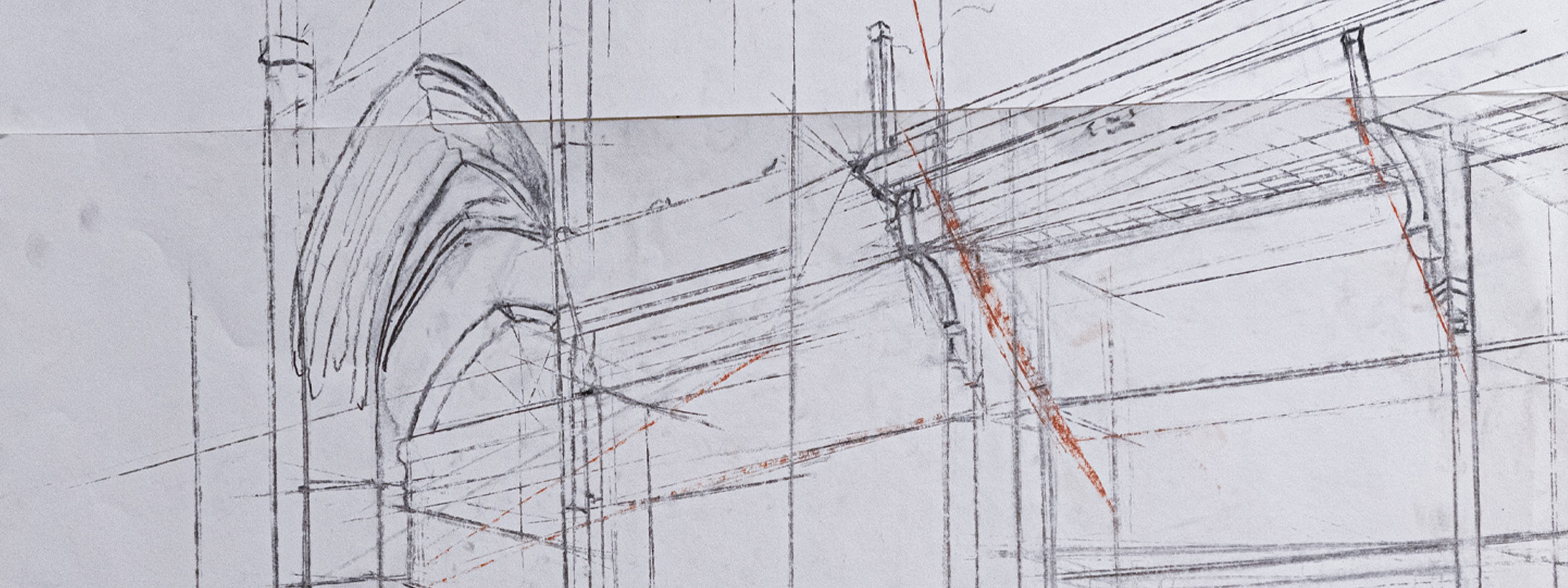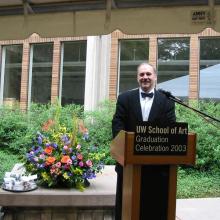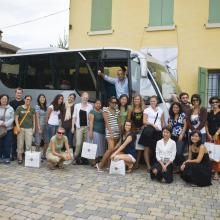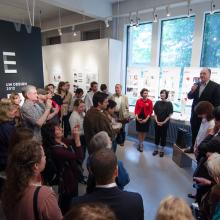Visual Communication Design Professor Christopher Ozubko is retiring after 39 years. He began teaching in the School of Art in 1981 shortly after finishing his MFA in design at Cranbrook Academy of Art. Professor Emeritus Doug Wadden, who was on the hiring committee, says that Ozubko was recommended by Katherine McCoy. She headed the graphic design graduate program at Cranbrook, which was known at the time for being interdisciplinary and encouraging experimentation. Wadden says that the UW program was looking for "someone to add a different dimension to our Yale and Chicago IIT design education sensibility."
Ozubko became director of the School of Art in 1996, and he served in that capacity until 2014. He proposed the School's name change to School of Art + Art History + Design while director, but it did not become official until 2015. As noted by current director Jamie Walker, during Ozubko's tenure, the School began doing coordinated fundraising. This resulted in the creation of endowments to support faculty (for example, the Wyckoff Milliman Endowed Chair in Art) and funds for student scholarships. Two endowed funds carry his name: the Ozubko Design Student Support Fund and the Ozubko Endowed Graduate Student Support Fund, which provides funding in all three School divisions. He also successfully led the School through two economic downturns, and he brought the School's newsletter back into being in 1998.
International visitors and travel played a significant role for Ozubko. Over the years, he hosted visiting designers from Switzerland, the Netherlands, Germany, and China as well as designers from other parts of the USA. In 2005, Ozubko founded the Design in Rome Exploration Seminar, which he led each August / September for 12 straight years. He also organized several student field trips to academic institutions in China and a field trip to Japan, which included participation in the ICOGRADA Conference.
As Professor Emeritus Wadden said, Ozubko has continuously contributed to the design professional community, and he "has made a difference as a colleague, as School director, and as a mentor to hundreds of students." We thank Professor Ozubko for his many years of service and wish him well in his retirement.
Staff member Jeanette Mills recently asked Ozubko about his time at the University of Washington.
Do you have any notable memories from your first 15 years in Seattle and at the School?
Design was very different in 1981 when I began teaching. There were no computers as we know them now, so everything was done in the traditional manner. Instead, there were Compugraphic type machines that could be difficult to use. Also, each student had a desk in room 247. Many were there nearly 24/7, and I would interact with them when I came in on weekends to work on projects. Classes were structured differently then, with a two-hour break mid-day. All the Design faculty would go to the Faculty Club together for lunch on a regular basis. Overall, things were more relaxed.
In my second year, Glenn Webb (a professor of Asian art history) asked the Design faculty if we would be able to help the Nippon Design College set up a summer study program here. They were here a few weeks, and we used art history PhD students as interpreters. Being Canadian, I organized a field trip to Victoria and Vancouver. The experience made me aware of Japan, a country and culture I knew little about at the time, and organizing the program helped me to start making contacts with local design professionals and industry contacts such as printers. We continued that program for ten summers although they were not consecutive years.
While I was not very familiar with Japanese culture, I had been given exposure to a wide range of design and designers even when I was an undergraduate at University of Alberta in Edmonton. It was normal to have visitors from all over Europe, Asia, and the USA. In my second or third year at UW, one of my undergraduate professors asked if we wanted to partner in bringing a Dutch design exhibition to North America. We did, and it cost us very little. I thought it was important to expose our students to other design influences.
In our early years in Seattle, there was a photography gallery in Pioneer Square that was named Equivalents. It was run by Chase Rynd, and my wife, Susan, worked there for a few years. I designed promotional materials for the gallery. I met Sam Davidson of Davidson Galleries through Chase, and I ended up designing the monthly First Thursday Pioneer Square Gallery newsletter. Later, Chase was director of Security Pacific Gallery, and I worked on a catalog with artist Ginny Ruffner for them. I also met photographer Mel Curtis through Equivalents, and I later collaborated with him on a project for a construction company publication I designed. We have been friends and colleagues since then.
Why did you move from being a professor to being a lecturer from 1986 to 1989?
I wanted to spend more time on my own design practice, so I became a half-time lecturer. My wife, parents, and I gutted a space on 2nd Avenue in Belltown and built the studio, Ozubko Design. It was a time when I made a lot of professional connections and got involved with the AIGA in Seattle. I was able to do some avant-garde design and enter work in competitions. The studio designed a series of chapbooks with Stewart, Tabori & Chang in New York. I hired a number of photographers, writers, and illustrators for that project, which gave me even broader connections.
I was able to use the work I did during that period for my tenure and promotion exhibition. I returned to full-time work in 1990 as an associate professor. Because of the AIGA contacts I had made during those three years, I was asked to be the Seattle chapter president from 1990 to 1992. That gave me contacts in chapters all over the USA.
What made you interested in becoming director of the School?
I really had not thought about becoming director; I did not know much about the position. In 1996, not long after I had been promoted to full professor, I got a call asking me to have lunch with John Simpson, the dean of the College of Arts & Sciences. He wanted me to consider the position. I could not envision myself as director since I had not been trained for administrative work. My wife, Susan, encouraged me and pointed out that I would not know if I could do it until I tried, so I did.
What do you think were your significant accomplishments while director?
I started working on the name change of the School early on since I thought School of Art was not inclusive or representative of the Divisions of Art History and Design. There was resistance from higher administration over the years, so it took a long time to convince people. It did not become official until after I was director.
I hired good people, and I learned to deal with a few challenging and difficult people. One of the good people was Mark Rector who became our first in-house computer support person in 1996. Helping him create the School's state-of-the-art computer center in 2000 was one of my highlights as director.
Fundraising was important, too. Through Sam Davidson (mentioned above), I had met Allan Kollar who was a School alum. I designed catalogs for the art collections he was selling. Later, Allan and his wife became major financial supporters of the School, ultimately creating the Allan and Mary Kollar Endowed Chair in American Art History. There were many other benefactors who gave significantly during those years.
Creating the School's Graduation Celebration in 2003 was also important as a way to bring closure to our students' education and celebrate with family and friends who supported them along the way. Judi Clark and her staff in the Academic Advising Office were instrumental in making that happen. We held it in the Art Building courtyard for the first two years, and our first guest speaker was Allan Kollar. We moved it to the Quad in 2005 then to Kane Hall in 2006.
What prompted you to create the Design in Rome Exploration Seminar?
I first went to Rome in 1976 as an undergraduate. I went again in the 1990s when Jamie Walker was leading a program there. I attended some critiques and tagged along on some field trips, and I started to really like Rome. I went again a couple years later when Design professor Judy Anderson was teaching there. In 2003, I was able to stay at the UW Rome Center in the Palazzo Pio while attending a ATYPI conference in Rome. I visited the Epigraphy Museum (Museo Nazionale Romano - Terme di Diocleziano) and learned about inscribing text in stone, which made me realize there were many opportunities and resources that related to my interest in typography. I spent more time in Rome during winter 2004 and started to seriously plan for a study abroad program.
The first seminar was launched in 2005. Our studio base was the UW Rome Center, but I always got the students out of the city and into some of the smaller towns, exposing them to the culture and crafts of Italy. We did our last program in 2016. It was becoming more expensive, and many Design students felt they needed to participate in summer internships rather than study abroad. Over the course of 12 years, 185 undergraduate + graduate students participated in the program.
Were you happy to return to a teaching focus in 2014?
Yes and no. A lot had changed in terms of technology and there had been significant modifications to the curriculum. It was difficult to keep up with all of that while I was director. There was less engagement because students had their own laptops and did not stay in the studios as much after class. Also, the interests and mind set of students was very different, so teaching could be more challenging.
Do you have any words of wisdom for alumni, current students, and/or incoming students?
The UW is a great university, and our Division of Design has fantastic faculty and programs. The quality of work created by our undergraduates exceeds numerous other institutions. We also have great graduate students, many of whom have become leaders in the profession and/or academia.
I always encourage students to get out and experience the world. While it is hard to travel at the moment, and travel can be expensive at any time, it is your experiences that will catch the eye of interviewers. They are not going to ask about your grades, but they will be interested in your vision of the world.
For all our alums, I encourage you to stay in touch. Let us know what you are doing.
Are there any other topics you would like to address?
I feel very lucky and blessed to have come to the UW. Other institutions were an option, and not a lot was happening in Seattle in 1981. Now Seattle is an international city, and the UW is a world-class institution. When I talk with people in Europe and Asia, Seattle is often at the top of their list for travel. They want to talk about Kurt Cobain, grunge music, Ichiro, Microsoft, Amazon, Boeing, and Eddie Bauer.
What are some of your retirement plans?
I will be writing, designing, and creating a lecture and books on teaching, study abroad, and the evolution of my career. The Division of Design will be hosting a lecture by me in late April 2021. I also will have some leisure time, hopefully travel, and I will take on my next design challenge, a grandchild in October.





